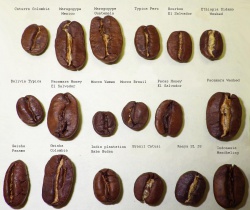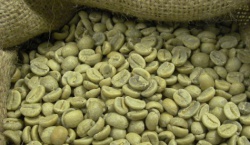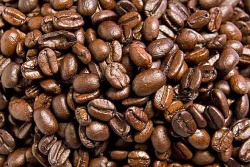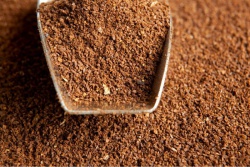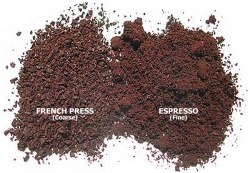Difference between revisions of "Caffeine Extraction"
| (6 intermediate revisions by the same user not shown) | |||
| Line 16: | Line 16: | ||
“Green coffee” is the colloquial name for coffee that has undergone harvesting, processing on a farm, however the coffee has not yet been roasted. The name is derived by the appearance of the bean itself. (picture) | “Green coffee” is the colloquial name for coffee that has undergone harvesting, processing on a farm, however the coffee has not yet been roasted. The name is derived by the appearance of the bean itself. (picture) | ||
| − | Extraction of Caffeine from Green Coffee only differs from the other extraction methods on this page in that one must first properly prepare, and homogenize, the green coffee sample. Green Coffee beans are very dense and difficult to grind, chop, or otherwise break down using traditional mechanical methods. Thus, one must first freeze the green coffee sample using liquid Nitrogen. Freezing the sample with liquid Nitrogen | + | Extraction of Caffeine from Green Coffee only differs from the other extraction methods on this page in that one must first properly prepare, and homogenize, the green coffee sample. Green Coffee beans are very dense and difficult to grind, chop, or otherwise break down using traditional mechanical methods. Thus, one must first freeze the green coffee sample using liquid Nitrogen. Freezing the sample with liquid Nitrogen. |
| + | |||
| + | ===Example method=== | ||
| + | |||
| + | *5g green coffee | ||
| + | *Add to mortar and pestle | ||
| + | *Add liquid nitrogen to freeze coffee | ||
| + | *Homogenize with mortar and pestle | ||
| + | *Once Homogenized add to 100 ml Beaker | ||
| + | *Add 50ml de-ionized water | ||
| + | *Add stir bar | ||
| + | *Stir for 30 minutes | ||
| + | *Filter out particulate | ||
| + | *Reserve filtrate for [[Caffeine_HPLC_Method|HPLC analysis]] | ||
==Roasted Coffee== | ==Roasted Coffee== | ||
[[File:Roasted-coffee-beans-590.jpg|thumb|250px|frame|right|Roasted Coffee Beans]] | [[File:Roasted-coffee-beans-590.jpg|thumb|250px|frame|right|Roasted Coffee Beans]] | ||
Roasted coffee is coffee that has undergone the roasting process; however, has not yet been ground. It is generally understood that a substantial amount of chemical reactions take place within the green coffee bean as it undergoes roasting. Therefore, it is often of interest to investigate coffee before and after roasting in order to ascertain if caffeine content is affected. | Roasted coffee is coffee that has undergone the roasting process; however, has not yet been ground. It is generally understood that a substantial amount of chemical reactions take place within the green coffee bean as it undergoes roasting. Therefore, it is often of interest to investigate coffee before and after roasting in order to ascertain if caffeine content is affected. | ||
| + | |||
| + | ===Example method=== | ||
| + | |||
| + | *5g whole bean coffee | ||
| + | *Add to mortar and pestle | ||
| + | *Homogenize with mortar and pestle | ||
| + | *Once Homogenized add to 100 ml Beaker | ||
| + | *Add 50ml de-ionized water | ||
| + | *Add stir bar | ||
| + | *Stir for 30 minutes | ||
| + | *Filter out particulate | ||
| + | *Reserve filtrate for [[Caffeine_HPLC_Method|HPLC analysis]] | ||
| + | |||
==Ground Coffee== | ==Ground Coffee== | ||
[[File:ARABICA_GROUND_COFFEE_BEANS_.jpg|thumb|250px|frame|right|Ground Coffee Beans]] | [[File:ARABICA_GROUND_COFFEE_BEANS_.jpg|thumb|250px|frame|right|Ground Coffee Beans]] | ||
| Line 28: | Line 54: | ||
Ground Coffee samples can be prepared for HPLC analysis by adding a portion of ground coffee to a beaker. Add de-ionized water and stir for one hour. The resultant liquid will contain a representative concentration of caffeine. A sample may be obtained for HPLC analysis by using a syring taking special care to filter the syrnge before injection into an HPLC vial. | Ground Coffee samples can be prepared for HPLC analysis by adding a portion of ground coffee to a beaker. Add de-ionized water and stir for one hour. The resultant liquid will contain a representative concentration of caffeine. A sample may be obtained for HPLC analysis by using a syring taking special care to filter the syrnge before injection into an HPLC vial. | ||
| − | ===Example method | + | ===Example method=== |
*5g ground coffee | *5g ground coffee | ||
| − | *50ml de-ionized water | + | *Add to 100 ml Beaker |
| − | *stir bar | + | *Add 50ml de-ionized water |
| − | + | *Add stir bar | |
*Stir for 30 minutes | *Stir for 30 minutes | ||
*Filter out particulate | *Filter out particulate | ||
| Line 43: | Line 69: | ||
For the purposes of quantifying concentration of caffeine in coffee samples, brewed coffee may be loaded directly into the high pressure liquid chromatograph (HPLC) and [[Caffeine_HPLC_Method|caffeine analysis]] conducted without further sample preparation. | For the purposes of quantifying concentration of caffeine in coffee samples, brewed coffee may be loaded directly into the high pressure liquid chromatograph (HPLC) and [[Caffeine_HPLC_Method|caffeine analysis]] conducted without further sample preparation. | ||
| + | |||
| + | ===Example method=== | ||
| + | |||
| + | * Direct [[Caffeine_HPLC_Method|HPLC analysis]] of caffeine content is possible. | ||
Latest revision as of 14:52, 19 April 2016
Extraction of Caffeine from Coffee
Introduction The extraction of caffeine from coffee is a fundamental metric by which one might compare coffee’s grown from around the world. Through the life of a coffee bean there exists multiple points at which caffeine might be extracted and quantified through the use of high pressure liquid chromatography (HPLC). The HPLC is conducted the precisely the same no matter the origin of the caffeine sample; be it caffeine extracted from green, roasted, ground, or brewed coffee. What does differ amongst these methods of analysis is the preparation of sample through the extraction of caffeine. In this paper the methods of extraction of caffeine will be reviewed and a method of caffeine analysis using HPLC, with UV/Vis detection, will be elucidated.
Optimal extraction of a chemical species from organic material is highly dependent on the particle size of the organic material being extracted from. Thus, it is understandable that each extraction method will differ in the initial preparation of organic material in order to produce a homogenous organic sample with a minimal particle size. If one’s intent is to compare samples from multiple states of existence (e.g. green coffee vs roasted coffee) one should strive to achieve as close to sample particle homogeneity across the research as possible in order to reduce variability in HPLC data due to non-uniform extraction protocols. (citation needed)
Green Coffee
“Green coffee” is the colloquial name for coffee that has undergone harvesting, processing on a farm, however the coffee has not yet been roasted. The name is derived by the appearance of the bean itself. (picture)
Extraction of Caffeine from Green Coffee only differs from the other extraction methods on this page in that one must first properly prepare, and homogenize, the green coffee sample. Green Coffee beans are very dense and difficult to grind, chop, or otherwise break down using traditional mechanical methods. Thus, one must first freeze the green coffee sample using liquid Nitrogen. Freezing the sample with liquid Nitrogen.
Example method
- 5g green coffee
- Add to mortar and pestle
- Add liquid nitrogen to freeze coffee
- Homogenize with mortar and pestle
- Once Homogenized add to 100 ml Beaker
- Add 50ml de-ionized water
- Add stir bar
- Stir for 30 minutes
- Filter out particulate
- Reserve filtrate for HPLC analysis
Roasted Coffee
Roasted coffee is coffee that has undergone the roasting process; however, has not yet been ground. It is generally understood that a substantial amount of chemical reactions take place within the green coffee bean as it undergoes roasting. Therefore, it is often of interest to investigate coffee before and after roasting in order to ascertain if caffeine content is affected.
Example method
- 5g whole bean coffee
- Add to mortar and pestle
- Homogenize with mortar and pestle
- Once Homogenized add to 100 ml Beaker
- Add 50ml de-ionized water
- Add stir bar
- Stir for 30 minutes
- Filter out particulate
- Reserve filtrate for HPLC analysis
Ground Coffee
Ground coffee has undergone roasting and has been further processed by grinding by any one of a multitude of methods. The primary goal of grinding roasted coffee beans is to produce a homogenous coffee material through which hot water extraction may occur during coffee brewing. The particle size of coffee grounds is directly related to caffeine extraction efficiency and as a fundamental variable under consideration in the preparation of coffee through various methods. (e.g. French Press, Espresso, etc.)
Ground Coffee samples can be prepared for HPLC analysis by adding a portion of ground coffee to a beaker. Add de-ionized water and stir for one hour. The resultant liquid will contain a representative concentration of caffeine. A sample may be obtained for HPLC analysis by using a syring taking special care to filter the syrnge before injection into an HPLC vial.
Example method
- 5g ground coffee
- Add to 100 ml Beaker
- Add 50ml de-ionized water
- Add stir bar
- Stir for 30 minutes
- Filter out particulate
- Reserve filtrate for HPLC analysis
Brewed Coffee
Brewed Coffee is ground coffee that has undergone an aqueous extraction. There is a wide array of methods through which one might brew coffee including methods in which the temperature of water, time of extraction, size of coffee ground, or the pressure of the system might be manipulated in one way or another.
For the purposes of quantifying concentration of caffeine in coffee samples, brewed coffee may be loaded directly into the high pressure liquid chromatograph (HPLC) and caffeine analysis conducted without further sample preparation.
Example method
- Direct HPLC analysis of caffeine content is possible.

